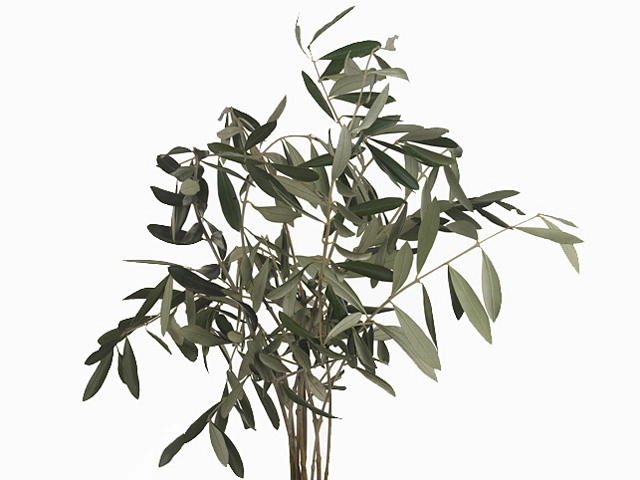Olea europaea per bunch

| Leaf arrangement | crosswise opposite |
| Leaf tip | Mucronate |
| Leaf margin | Entire |
| Leaf, general shape | Lanceolate |
| Leaf surface | Smooth; Dull |
| Leaf size | 5 - 7,5 cm |
| Leaf, main color | Dark green |
| Leaf colour, pattern | Unicolored |
The Olea europaea, also known as the olive tree, is a stunning plant that is widely recognized for its numerous benefits and iconic presence. Each bunch of Olea europaea is adorned with beautiful lanceolate-shaped leaves that display a dark green hue, giving them a striking appearance.
As we observe the structure of the leaves, we notice that they are arranged crosswise opposite each other, creating a harmonious and symmetrical pattern. Additionally, the leaf tips exhibit a small, pointed extension called a mucronate, adding an interesting feature to their overall shape.
One distinct characteristic of the Olea europaea's leaves is their smooth and dull surface. This unique texture gives the leaves a matte finish, distinguishing them from other plants that may have a glossy appearance. The absence of roughness on the leaf surface also contributes to the plant's delicate and refined aesthetics.
Measuring between 5 to 7.5 cm in length, these leaves provide a moderate size, allowing them to blend effortlessly with other foliage in various settings. Their relatively narrow shape makes them lanceolate, tapering gradually towards the apex, further adding to their charm and elegance.
The main color of these leaves is a deep, rich dark green. The intensity of this hue can vary slightly depending on factors such as sunlight availability and the plant's health. Nevertheless, the dark green shade brings a touch of serenity and freshness to any environment.
To complement the leaf's general features, the colour pattern remains unicolored throughout. This means that the leaves do not exhibit any eye-catching patterns or variations in color, adding to their simplicity and understated beauty. The absence of patterns allows the leaves to serve as a versatile backdrop, easily integrating into different designs and themes.
The Olea europaea's leaves are not only visually appealing but also hold significant cultural and economic value. The olive tree is widely cultivated for its fruits, which are commonly used in the production of olive oil. The leaves themselves possess medicinal properties and are often used to create essential oils that offer an array of health benefits.
In conclusion, the Olea europaea's bunches of leaves offer a breathtaking sight, with their crosswise opposite arrangement, mucronate tips, entire margins, lanceolate shape, smooth and dull surfaces, and dark green unicolored coloration. They are not only visually appealing but also deeply intertwined with Mediterranean culture and play a vital role in the production of olive oil. Whether in a garden, a culinary setting, or for their medicinal properties, the Olea europaea's leaves are undeniably captivating.
Market availability index by month:
| Jan. | Feb. | Mar. | Apr. | May | Jun. | Jul. | Aug. | Sep. | Oct. | Nov. | Dec. |
|---|---|---|---|---|---|---|---|---|---|---|---|
| 4 | 4 | 3 | 3 | 4 | 3 | 3 | 3 | 3 | 3 | 3 | 3 |